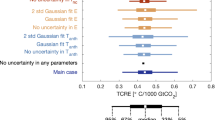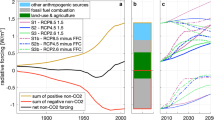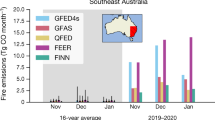Abstract
Many future energy and emission scenarios envisage an increase of bioenergy in the global primary energy mix1,2,3,4. In most climate impact assessment models and policies, bioenergy systems are assumed to be carbon neutral, thus ignoring the time lag between CO2 emissions from biomass combustion and CO2 uptake by vegetation5. Here, we show that the temperature peak caused by CO2 emissions from bioenergy is proportional to the maximum rate at which emissions occur and is almost insensitive to cumulative emissions. Whereas the carbon–climate response (CCR; ref. 6) to fossil fuel emissions is approximately constant, the CCR to bioenergy emissions depends on time, biomass turnover times, and emission scenarios. The linearity between temperature peak and bioenergy CO2 emission rates resembles the characteristic of the temperature response to short-lived climate forcers. As for the latter7,8,9, the timing of CO2 emissions from bioenergy matters. Under the international agreement to limit global warming to 2 °C by 21003, early emissions from bioenergy thus have smaller contributions on the targeted temperature than emissions postponed later into the future, especially when bioenergy is sourced from biomass with medium (50–60 years) or long turnover times (100 years).
This is a preview of subscription content, access via your institution
Access options
Subscribe to this journal
Receive 12 print issues and online access
$209.00 per year
only $17.42 per issue
Buy this article
- Purchase on Springer Link
- Instant access to full article PDF
Prices may be subject to local taxes which are calculated during checkout



Similar content being viewed by others
References
Vuuren, D. et al. RCP2.6: Exploring the possibility to keep global mean temperature increase below 2 °C. Climatic Change 109, 95–116 (2011).
Thomson, A. et al. RCP4.5: A pathway for stabilization of radiative forcing by 2100. Climatic Change 109, 77–94 (2011).
Rogelj, J. et al. Emission pathways consistent with a 2 °C global temperature limit. Nature Clim. Change 1, 413–418 (2011).
Riahi, K. et al. RCP 8.5—A scenario of comparatively high greenhouse gas emissions. Climatic Change 109, 33–57 (2011).
Bernier, P. & Paré, D. Using ecosystem CO2 measurements to estimate the timing and magnitude of greenhouse gas mitigation potential of forest bioenergy. GCB Bioenergy 5, 67–72 (2013).
Matthews, H. D., Gillett, N. P., Stott, P. A. & Zickfeld, K. The proportionality of global warming to cumulative carbon emissions. Nature 459, 829–832 (2009).
Bowerman, N. H. A. et al. The role of short-lived climate pollutants in meeting temperature goals. Nature Clim. Change 3, 1021–1024 (2013).
Smith, S. M. et al. Equivalence of greenhouse-gas emissions for peak temperature limits. Nature Clim. Change 2, 535–538 (2012).
Shine, K. P., Berntsen, T. K., Fuglestvedt, J. S., Skeie, R. B. & Stuber, N. Comparing the climate effect of emissions of short- and long-lived climate agents. Phil. Trans. R. Soc. A 365, 1903–1914 (2007).
Melillo, J. M. et al. Indirect emissions from biofuels: How important? Science 326, 1397–1399 (2009).
EPA Deferral for CO 2 Emissions From Bioenergy and Other Biogenic Sources Under the Prevention of Significant Deterioration (PSD) and Title V Programs Vol. 76 (EPA, 2011).
Myhre, G. et al. in Climate Change 2013: The Physical Science Basis (eds Stocker, T. F. et al.) Ch. 8 (IPCC, Cambridge Univ. Press, 2013).
Cherubini, F., Bright, R. M. & Strømman, A. H. Global climate impacts of forest bioenergy: What, when and how to measure? Environ. Res. Lett. 8, 014049 (2013).
Eby, M. et al. Lifetime of anthropogenic climate change: Millennial time scales of potential CO2 and surface temperature perturbations. J. Clim. 22, 2501–2511 (2009).
Joos, F. et al. Carbon dioxide and climate impulse response functions for the computation of greenhouse gas metrics: A multi-model analysis. Atmos. Chem. Phys. 13, 2793–2825 (2013).
Allen, M. R. et al. Warming caused by cumulative carbon emissions towards the trillionth tonne. Nature 458, 1163–1166 (2009).
Bright, R. M. et al. A comment to “Large-scale bioenergy from additional harvest of forest biomass is neither sustainable nor greenhouse gas neutral”: Important insights beyond greenhouse gas accounting. GCB Bioenergy 4, 617–619 (2012).
Stocker, T. F. The closing door of climate targets. Science 339, 280–282 (2013).
Zickfeld, K., Eby, M., Matthews, H. D. & Weaver, A. J. Setting cumulative emissions targets to reduce the risk of dangerous climate change. Proc. Natl Acad. Sci. USA 106, 16129–16134 (2009).
Shindell, D. et al. Simultaneously mitigating near-term climate change and improving human health and food security. Science 335, 183–189 (2012).
Ciais, P. et al. Attributing the increase in atmospheric CO2 to emitters and absorbers. Nature Clim. Change 3, 926–930 (2013).
Gillett, N. P., Arora, V. K., Matthews, D. & Allen, M. R. Constraining the ratio of global warming to cumulative CO2 emissions using CMIP5 simulations*. J. Clim. 26, 6844–6858 (2013).
Shine, K., Fuglestvedt, J., Hailemariam, K. & Stuber, N. Alternatives to the global warming potential for comparing climate impacts of emissions of greenhouse gases. Climatic Change 68, 281–302 (2005).
Ciais, P. et al. in Climate Change 2013: The Physical Science Basis (eds Stocker, T. F. et al.) Ch. 6 (IPCC, Cambridge Univ. Press, 2013).
Friedlingstein, P. et al. Long-term climate implications of twenty-first century options for carbon dioxide emission mitigation. Nature Clim. Change 1, 457–461 (2011).
Hallgren, W. et al. Climate impacts of a large-scale biofuels expansion. Geophys. Res. Lett. 40, 1624–1630 (2013).
Field, C. B., Campbell, J. E. & Lobell, D. B. Biomass energy: The scale of the potential resource. Trends Ecol. Evol. 23, 65–72 (2008).
Gonçalves, J. L. M. et al. Soil fertility and growth of Eucalyptus grandis in Brazil under different residue management practices. Southern Hemisphere Forest. J. 69, 95–102 (2007).
Amiro, B. D. et al. Ecosystem carbon dioxide fluxes after disturbance in forests of North America. J. Geophys. Res. 115, G00K02 (2010).
Magnani, F. et al. The human footprint in the carbon cycle of temperate and boreal forests. Nature 447, 849–851 (2007).
Acknowledgements
F.C., R.M.B. and A.H.S. acknowledge support from the projects CENBIO, CLIMPOL and ECOSERVICE, funded by the Norwegian Research Council. P.C. acknowledges support from the ERC-SYG grant P-IMBALANCE.
Author information
Authors and Affiliations
Contributions
F.C. and T.G. conducted the preliminary design of the study and the experiments; all authors discussed the specific goal and scope of the analysis and the presentation of the results; T.G. computed the carbon-cycle and climate responses; F.C. elaborated the data and ran the simulations under various emission scenarios; F.C. wrote the paper with contributions from all the authors.
Corresponding author
Ethics declarations
Competing interests
The authors declare no competing financial interests.
Supplementary information
Rights and permissions
About this article
Cite this article
Cherubini, F., Gasser, T., Bright, R. et al. Linearity between temperature peak and bioenergy CO2 emission rates. Nature Clim Change 4, 983–987 (2014). https://doi.org/10.1038/nclimate2399
Received:
Accepted:
Published:
Issue Date:
DOI: https://doi.org/10.1038/nclimate2399
This article is cited by
-
Cooling aerosols and changes in albedo counteract warming from CO2 and black carbon from forest bioenergy in Norway
Scientific Reports (2018)
-
The contribution of China’s emissions to global climate forcing
Nature (2016)
-
Global spatially explicit CO2 emission metrics for forest bioenergy
Scientific Reports (2016)
-
The Transient Response to Cumulative CO2 Emissions: a Review
Current Climate Change Reports (2016)
-
Negative emissions physically needed to keep global warming below 2 °C
Nature Communications (2015)



